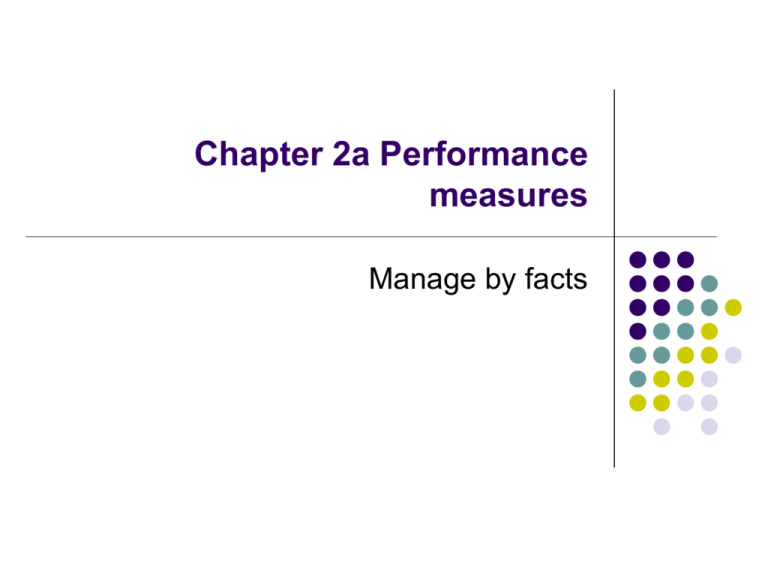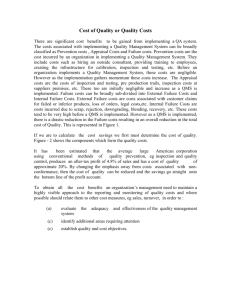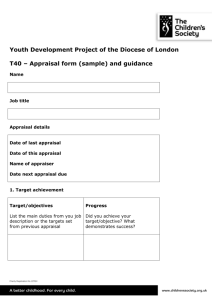Chapter 2a Performance measures
advertisement

Chapter 2a Performance measures Manage by facts Performance measures One of core values in MBNQA is manage by facts – not gut feelings Effective management requires info from measurement activities Performance measures used as baseline to identify potential project - justify project resource allocation - assess improvement results Production – defects per million (or ppm), inventory turns, on-time delivery Service activities – billing errors, sales per square feet, engineering changes, activity times, etc. Cost of poor quality In the final analysis - value of QC / QA / TQM initiative and programs are based on ability to contribute to profits. An effective performance measure is cost of poor quality- decisions depends on expense and income of the business activity. Efficiency of any business measured in RM, $ (monetary value) Costs of poor quality can be found – same as for cost of maintenance, production, design, inspection, etc. We can measure, program, analyze and budget the cost of poor quality (COPQ) or (PONC) to achieve better quality and customer satisfaction. Cost of poor quality COSTS , PROFIT Quality costs involves all department; purchasing, design, etc. What is quality costs? Cost of poor quality are “those costs associated with non-achievement of product/service quality defined by the requirements” Cost of poor quality Quality cost - used in pursuit of quality improvement, customer satisfaction, and basic data for TQM High quality cost – inefficient, ineffective management Quality Cost Program quantifies magnitude quality problem in management language (RM); - 20% of sales dollars in manufacturing - 35% of sales dollars in service Need to develop Quality Cost Program Identify opportunities for improvement Justification for corrective action Every sen saved will profits - Take care of the penny and penny will take care of itself!! Cost of poor quality Principle advantage – identify hidden costs which is not able to detect in operation Program – comprehensive and not ‘firefighting’ problem Real improvement occurs – ROOT CAUSE OF PROBLEM identified and eliminated Quality Costs Categories Prevention Prevention achieved by examining experience gained from identification of specific causes of failures, and developing specific activities incorporated into basic management system that make it difficult or impossible for error/failure to occur again Cost incurred for planning, implementing & maintenance a quality system to ensure conformance to requirements Design review, Quality Management system, Measuring Equipment Calibration Quality Costs Categories Appraisal Cost incurred to determine degree on conformance to quality requirements Examples – incoming inspection, source inspection, operations inspections, measuring equipment Quality Costs Categories Failures - Internal failure - External failure Cost incurred when products/services, components, materials, fail to meet requirements 1) before, 2) after transfer of ownership to customer Internal - purchasing errors, rework, repair, scrap, reappraisal, etc. External - complaint investigation, returned goods, retrofit. Warranty costs, liability costs, etc Collection and Reporting Quality Data Current month Prevention costs RM (000) Yr to date Current Current month Prior Yr Appraisal Costs Marketing/Customer Product/Service development Product/Service development Purchasing Purchasing Operations Operations External Appraisal Quality Administration Total Internal failure Costs RM (000) RM (000) Yr to date Current Prior Yr Total Current month Product/Service Design Yr to date Current External Failure Costs Prior Yr RM (000) Current month Customer complaints Purchasing Returned Goods Operations (Subtotal) Retrofit Costs Material Warranty Claims Rework Liability Costs Repair Penalties Scrap Customer Goodwill Yr to date Current Prior Yr Total Baseline Data Net Sales RM (000) Current month Ratios Current Prior Yr External Failure Cost/Net Sales Direct Labor Operations Failure Costs/Prod Costs Production Operations Appraisal Costs/Production Costs Unit Purchasing Costs of Poor Quality/Material Costs Design Costs of Poor Quality/Design Costs RM (000) Current month Yr to date Current Prior Yr Quality Costs QUALITY COST REPORT for control purposes establish budget variances measured ANALYSIS 1) Trend analysis by cost categories (P-A-F) product indices (baseline) plants in the corporation 2) Pareto Analysis categories department product lines, e.g. failure costs, warranty costs, appraisal Cost incurred to determine degree on conformance to quality requirements Examples – incoming inspection, source inspection, operations inspections, measuring equipment Optimum Costs Mgmt. wants to know optimum costs when analyzing quality costs (this is difficult to specify). Propose techniques Technique #1 Make comparisons with other companies - difficult Technique #2 Optimize individual categories e.g. Failure costs optimized when no identifiable & profitable projects to reduce them Technique #3 Analyze relationship between different cost categories As Quality Improves () - 100% conformance, Failure costs will decrease ( ~ 0 ), therefore need to Prevention and Appraisal costs Combine TQ cost curves ; Q , QUALITY COSTS ( but 100% ~ costs may become infinity) Perfection is achievable, if 99.9% conformance (i.e. 1 error in 1000); 16,000 pieces of lost mail every hour, 500 failed surgical operations each week, 2 unsafe airplane landings at O’Hare airport, 22,000 wrong checks deduction, 2 million dead/sick food poisoning each year, etc. Quality Improvement Strategy Guiding Principles 1. 2. 3. All failures/problems has ROOT CAUSE Causes are preventable Prevention cheaper than cure Based on the three principles, possible strategy is as follows: Reduce failure costs by problem solving Invest in the ‘right’ prevention actions Reduce appraisal costs where appropriate ~ statistically sound Continuously evaluate & redirect prevention effort to gain further improvement Malcolm Baldrige National Quality Award (MBNQA) Annual award to recognize US organizations for performance excellence Established Public Law 100-107 on August 1987 Award promotes : understanding of the requirements for performance excellence and competitiveness improvement sharing of information on successful performance strategies, and benefits derived form those strategies Malcolm Baldrige National Quality Award 5 categories – manufacturing, service, small business, health care, education Organizations use criteria as a technique to measure their TQM effort on an annual basis (conduct self assessment) Core values and concepts embodied in seven categories Categories further subdivided into examination items – 19 items (always improving) MBNQA Framework MBNQA Criteria and Score Other performance measures Balanced scorecard – Customer Measures, Financial measures, Learning and growth, internal processes (integrated as strategic management and communication tools) Six sigma program – what sigma level






